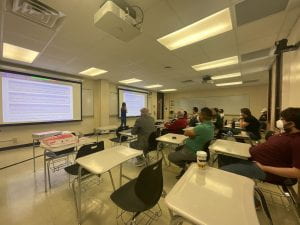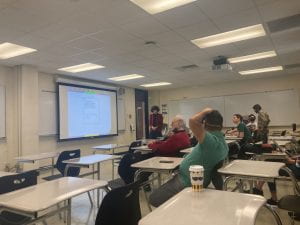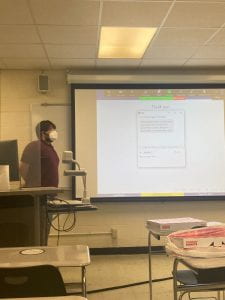Author: cyang3
2022 Faudree’s Research day
Snapshots of the 2022 Faudree’s Research day








2021 Hugo Steinhaus Prize
Irena Lasiecka is a laureate of 2021 Hugo Steinhaus Prize awarded by the Polish Society of Mathematics.
2022 Carnegie R1 Research Celebration Event
The Faculty of the Department of Mathematical Sciences has been recognized during the 2022 Carnegie R1 Research Celebration Event held by the Provost of Research Office on April 7, 2022.
- In the category of FY 2021 Principal Investigators: I. Lasiecka, A. Windsor, and B. Zheng.
- In the category of FY 2021 Book Publications: G. Anastassiou.
- In the category of Research Impact Top Faculty by Scopus H index: I. Lasiecka [47], B. Bollobas [43] and R. Triggiani [39].
PDE seminar
Title: Global attractors for a nonlinear boundary damped wave equation with nonlinear critical source.
Speaker: Dr. Madhumita Roy
Abstract: In this talk we shall consider a wave model in 3D on a bounded domain which contains nonlinear sources with critical exponent in the interior and nonlinear feedback dissipation on the boundary. Similar models with simpler nonlinear boundary terms have been already studied broadly whereas the generosity of our model is not only the presence of nonlinear damping but also nonlinear boundary source. Boundary actuators are easily accessible to external manipulations-hence feasible from the engineering point of view and practically implementable. On the other hand, the underlying mathematics is challenging. Boundary actions are represented by unbounded, unclosable operators, hence not treatable by perturbation theory(even from the point of view of well-posedness theory.)
Our main result shows that a suitably calibrated boundary damping prevents the blow up of the waves and allows to contain these asymptotically (in time) in a suitable attracting set which is compact.
Time: Apr 15, 2022 02:00 PM Central Time (US and Canada)
Join Zoom Meeting
https://memphis.zoom.us/j/89234625016?pwd=S2hGbW5CZEJKNXZVbTc4bURhR21IZz09
Meeting ID: 892 3462 5016
Passcode: 363494
Ergodic Theory seminar: The Lightning Model
Title: The Lightning Model
Abstract: We introduce a non-standard model for percolation on the integer lattice $\Z^2$. Randomly assign to each vertex $a \in \Z^2$ a potential, denoted $\phi_a$, chosen independently and uniformly from the interval $[0, 1]$. For fixed $\epsilon \in [0,1]$, draw a directed edge from vertex $a$ to a nearest-neighbor vertex $b$ if $\phi_b < \phi_a + \ep$, yielding a directed subgraph of the infinite directed graph $\overrightarrow{G}$ whose vertex set is $\Z^2$, with nearest-neighbor edge set. We define notions of weak and strong percolation for our model, and observe that when $\ep = 0$ the model fails to percolate weakly, while for $\ep = 1$ it percolates strongly. We show that there is a positive $\epsilon_0$ so that for $0 \le \ep \le \ep_0$, the model fails to percolate weakly, and that when $\ep > p_\text{site}$, the critical probability for standard site percolation in $\Z^2$, the model percolates strongly. We study the number of infinite strongly connected clusters occurring in a typical configuration. We show that for these models of percolation on directed graphs, there are some subtle issues that do not arise for undirected percolation. Although our model does not have the finite energy property, we are able to show that, as in the standard model, the number of infinite strongly connected clusters is almost surely 0, 1 or $\infty$.
Location: DH 109
Time: 4/14/2022 1:00 pm.
Robust estimators to build reliable disease trajectories from short longitudinal data
Title: Robust estimators to build reliable disease trajectories from short longitudinal data
Speaker: Professor Tanya P Garcia, University of North Carolina, Chapel Hill
Abstract: Discovering therapies for neurodegenerative diseases is notoriously difficult, and made worse without accurate disease trajectories to identify when interventions will best prevent or delay irreparable damage. Modeling a disease trajectory is not easy. These diseases progress slowly over decades, and no study covers the full disease course due to time and cost constraints. To compensate, researchers model disease trajectories by piecing together short longitudinal data from patients at different disease stages. The challenge is how to piece together the data to create realistic disease trajectories. One promising way pieces together the short longitudinal data to show changes before and after major events on the disease timeline, like when disease onset occurs. This approach has helped produce realistic disease trajectories, but has shortcomings when the time of the disease event is unknown since without these times, we don’t know where to place the data on the disease timeline. To overcome this issue, researchers currently replace all unknown times with predicted times. Despite efforts to predict the time of disease events without bias using various models, the assumptions these models make often do not hold in practice and result in inaccurate predictions. This leads to an incorrect model of the disease trajectory, producing misleading conclusions about how quickly impairments change as the disease advances. We propose a series of estimators to model the disease trajectory around times of disease events without the need to predict times that are unknown. We show that our estimators produce accurate estimates of the trajectory around times of disease events even when we completely misspecified the distribution model of that time of disease event. We apply our methods to studies of Huntington disease where we model trajectories of motor impairments before and after times of major disease events, to help pinpoint when interventions will best prevent or delay irreparable damage.
Time: Apr 8, 2022 03:30 PM Central Time (US and Canada)
Colloquium Lecture
Bio of speaker: Gary Gordon is the Marshall R. Metzgar Professor of Mathematics at Lafayette College, where he’s been teaching since 1986. His research interests include combinatorics and finite geometry, but he likes math problems of all kinds. He served as the editor for The Playground, the problem solving column of Math Horizons, and he is also involved with the AMC10-12 contest. He has won multiple awards from the Math Association of America (MAA), and has co-authored two books. His favorite mathematical activity – writing The Joy of SET about the math behind the card game SET, with co-authors Liz McMahon, Hannah Gordon, and Rebecca Gordon, his wife and two daughters.
Combinatorics Seminar
Time: Friday, March 25, 2022, 1:00pm-2:00pm.
Location: DH 245
Title: A Chevalley Warning Theorem Modulo Differing Prime Powers
Speaker: David J. Grynkiewicz, U. Memphis
Abstract: Polynomial methods are a powerful algebraic tool that can be used to prove many interesting and otherwise difficult combinatorial results. One such tool is the Chevalley-Warning Theorem. It states that if $p$ is a prime, $f_1,\ldots,f_s\in \mathbb Z[X_1,\ldots, X_n]$ are polynomials and $$V=\{\textbf x\in [0,p-1]^n:\; f_1(\textbf x)\equiv 0,\;\ldots,\;f_s(\textbf{x})\equiv 0\mod p\}$$ is the set of all common roots of the polynomials $f_1,\ldots,f_s$ (modulo $p$), then $$|V|\equiv 0\mod p$$ provided $n> \sum_{i=1}^{s}\mathsf{deg} f_i$. In particular, if the polynomials have no constant term and the number of variables is larger than the sum of degrees, then there is guaranteed to be a nontrivial common root to all the polynomials.
There are many generalizations of this result, including those quantifying just how large a prime power $p^m$ divides the cardinality $|V|$. We will discuss these results and illustrate them by giving some examples of simple proofs of otherwise very difficult theorems. We will then talk about a seemingly un-noticed generalization of the Chevalley-Warning Theorem. By a rather straightforward modification of a proof of R. Wilson, one can obtain a version of the Chevalley-Warning Theorem applicable when the equations $f_1(\textbf x)\equiv 0\mod p^{m_1},\;\ldots,\;f_n(\textbf x)\equiv 0\mod p^{m_s}$ are considered modulo \emph{differing prime powers} of the common prime $p$. Using Hensel’s Lemma, which we will discuss in detail for those unfamiliar, we will explain how this result means any typical Chevalley-Warning argument modulo $p$ can effectively be implemented modulo varying primes powers $p^{m_1},\ldots,p^{m_s}$ of a common prime, with tight bounds for how large a prime power $p^m$ divides the cardinality of the corresponding set $V$. As one simple example, this gives a new proof of the Davenport Constant of a finite abelian $p$-group without need of using group algebras.
March’s Spotlight in the Division of Research + Innovation
Dr. Irena Lasiecka has been highlighted as one of the Highly Cited Faculty members for March’s Spotlight in the Division of Research + Innovation. Read the feature here.